Abstract
OBJECTIVE: To develop and validate a measure of contemporary life stressors. STUDY SETTING: Three interview studies: Study 1 (pilot), 32 caregivers receiving case management services for a child with chronic illness; Study 2 (validation), 311 caregivers of children receiving general pediatric care at a university clinic; Study 3 (reliability), 17 caregivers of children with a complex medical diagnosis. STUDY DESIGN: Study 1: item development via discussions with case managers; piloted with caregivers. Study 2 examined psychometric properties of the measure and correlated it with the CES-D, a measure of depressive symptomatology and the PRQ85-Part 2, a measure of perceived social support, to establish its convergent construct validity. Study 3 established the test-retest reliability of the measure over two weeks by correlating two administrations of the index. DATA COLLECTION: Face-to-face interviews in homes (Study 1) or in clinic waiting rooms (Studies 2 and 3) and by telephone (Study 3 retest). PRINCIPAL FINDINGS: The CRISYS is a flexible, multidimensional tool that demonstrates strong face, content, and construct validity, and excellent test-retest reliability. The format is easy to use and well accepted by respondents and is suitable for low-income populations. CONCLUSIONS: Researchers will find the CRISYS useful when evaluating the success of a clinical model or a healthcare system, and the effectiveness of an insurance plan or a government program. Clinicians may also find that the CRISYS is an effective screen for family needs.
Full text
PDF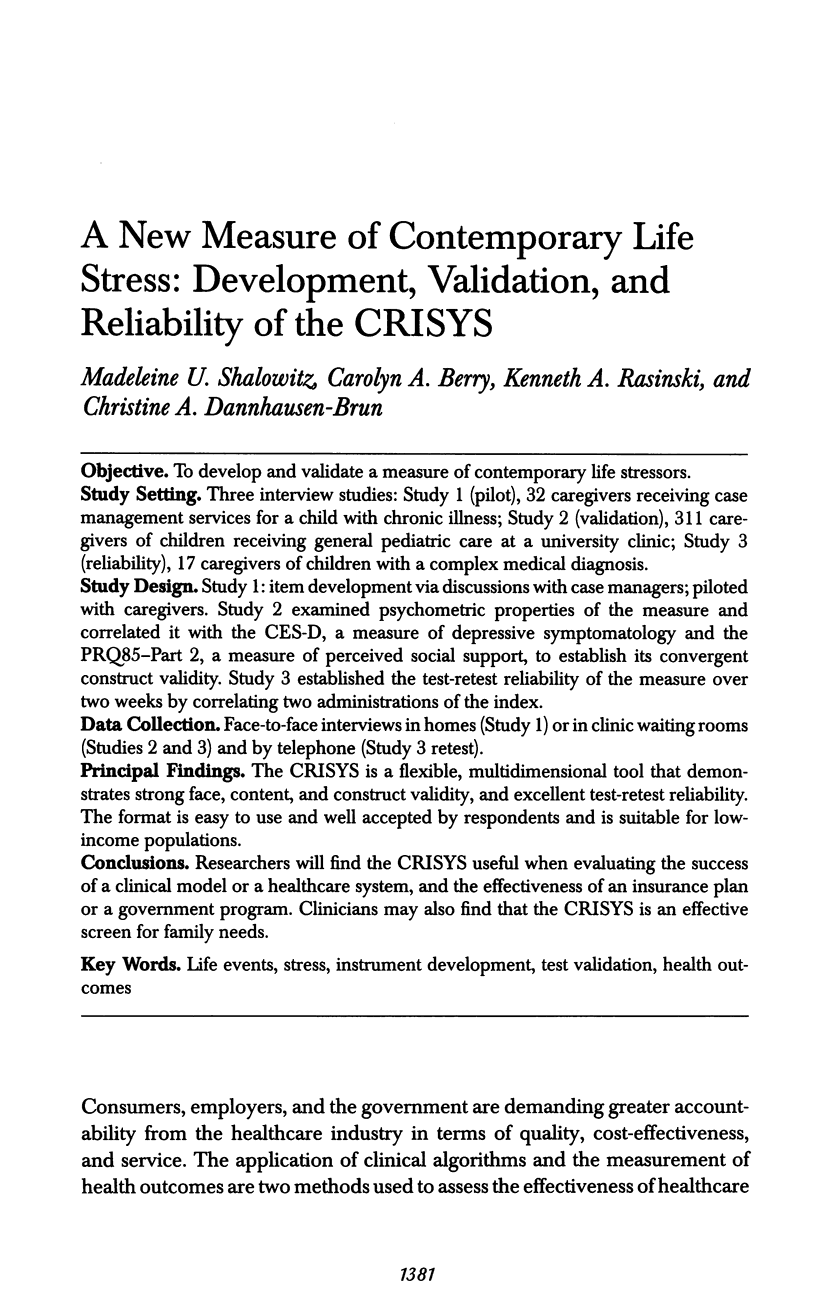
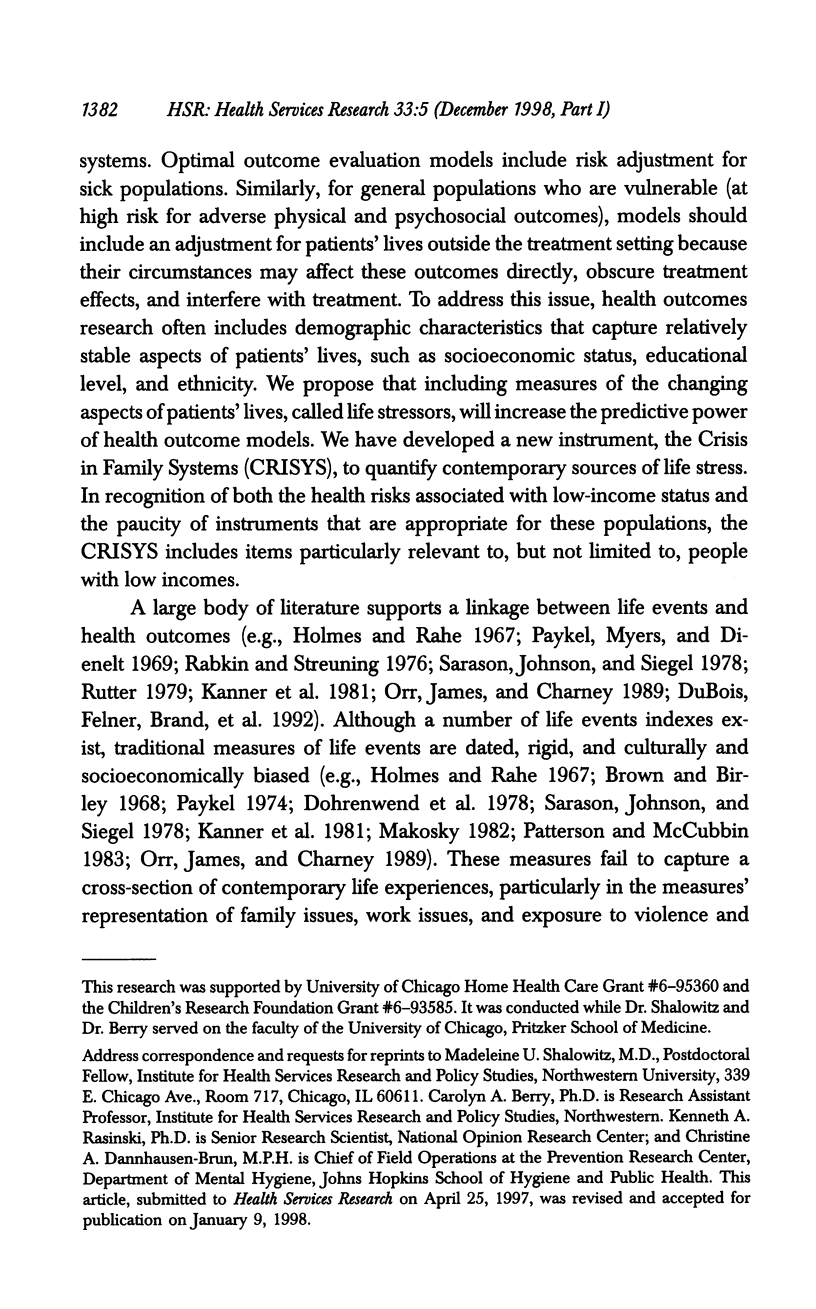
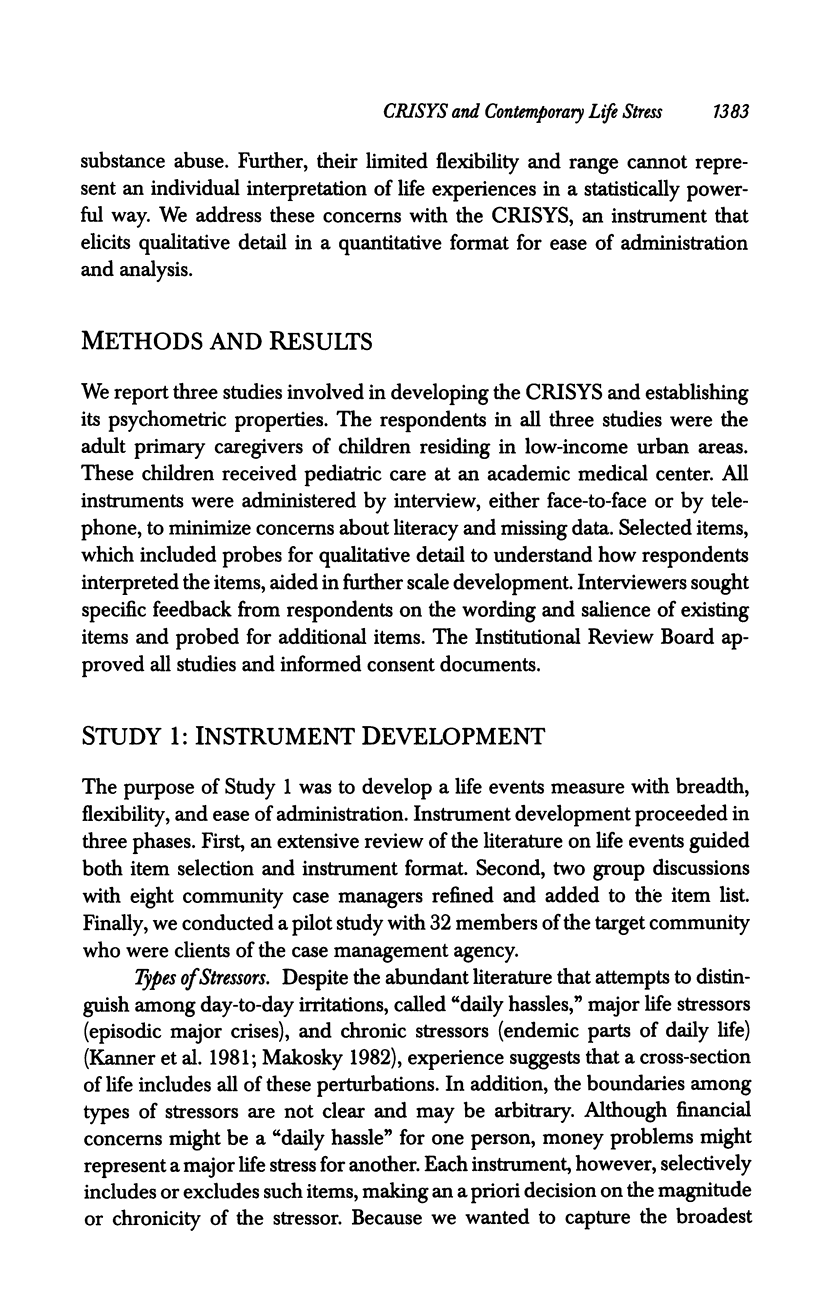

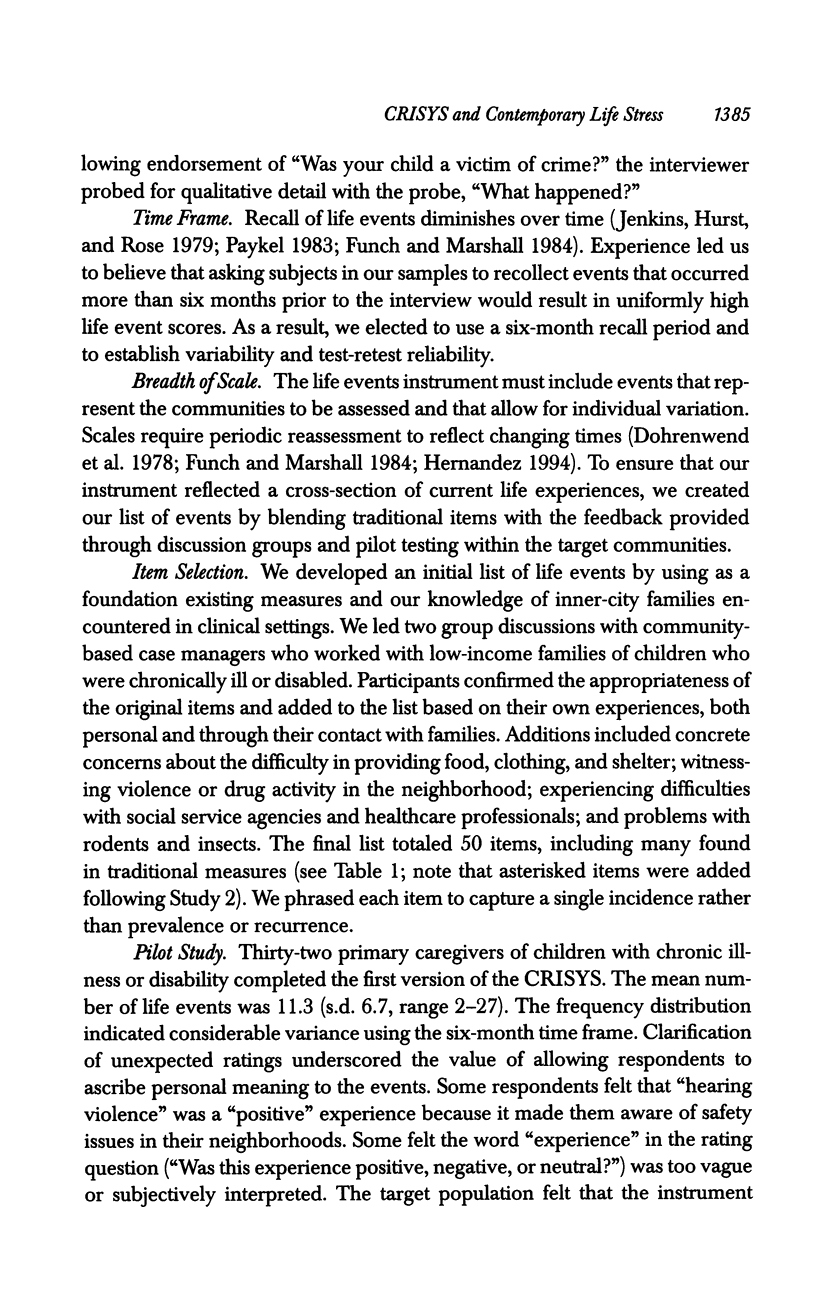

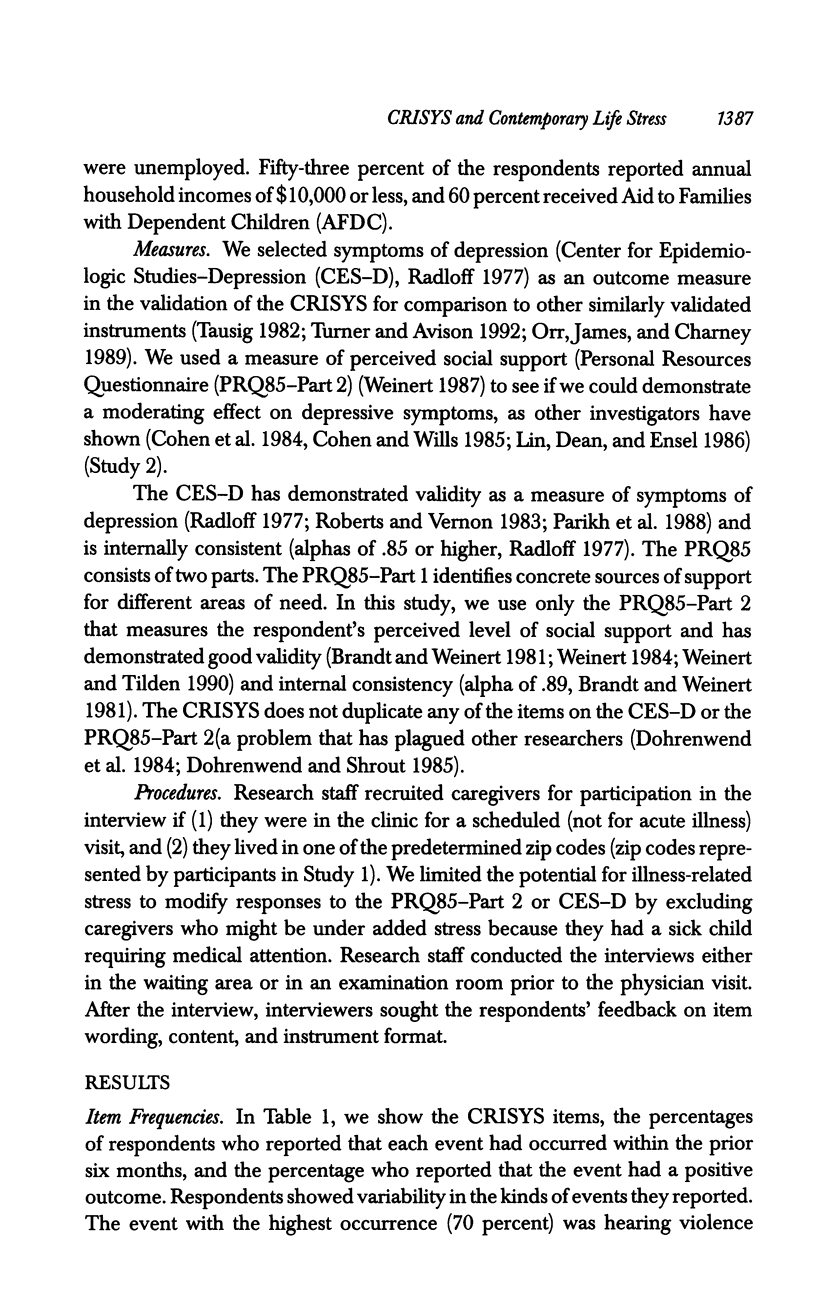
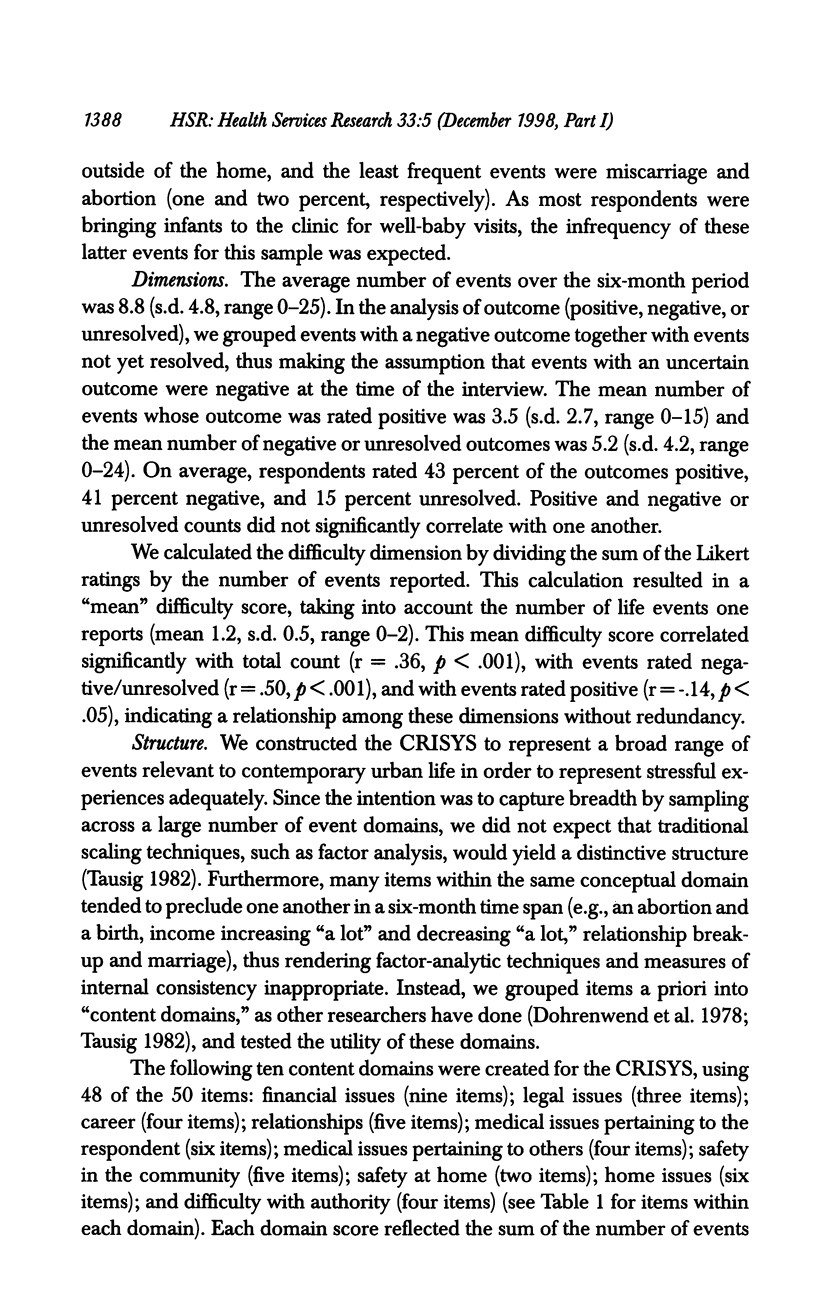



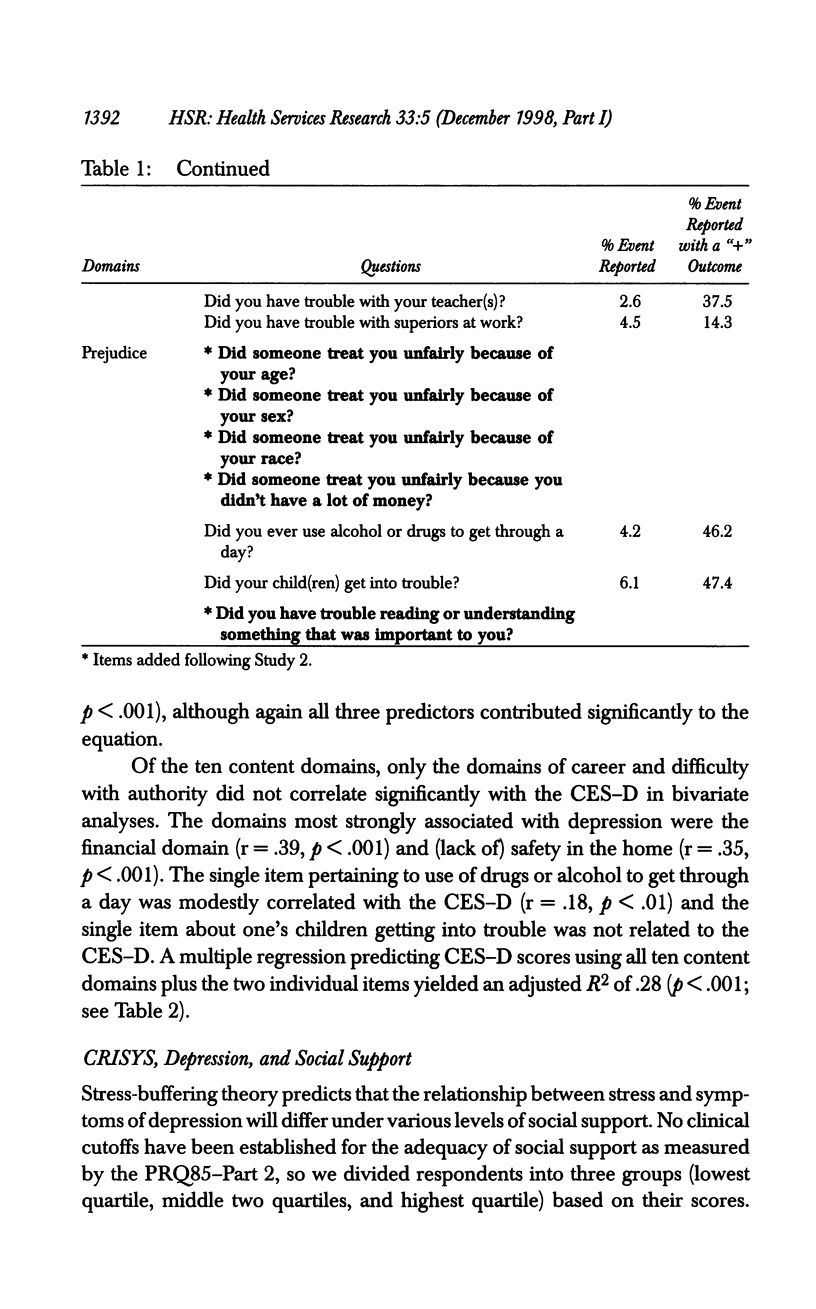
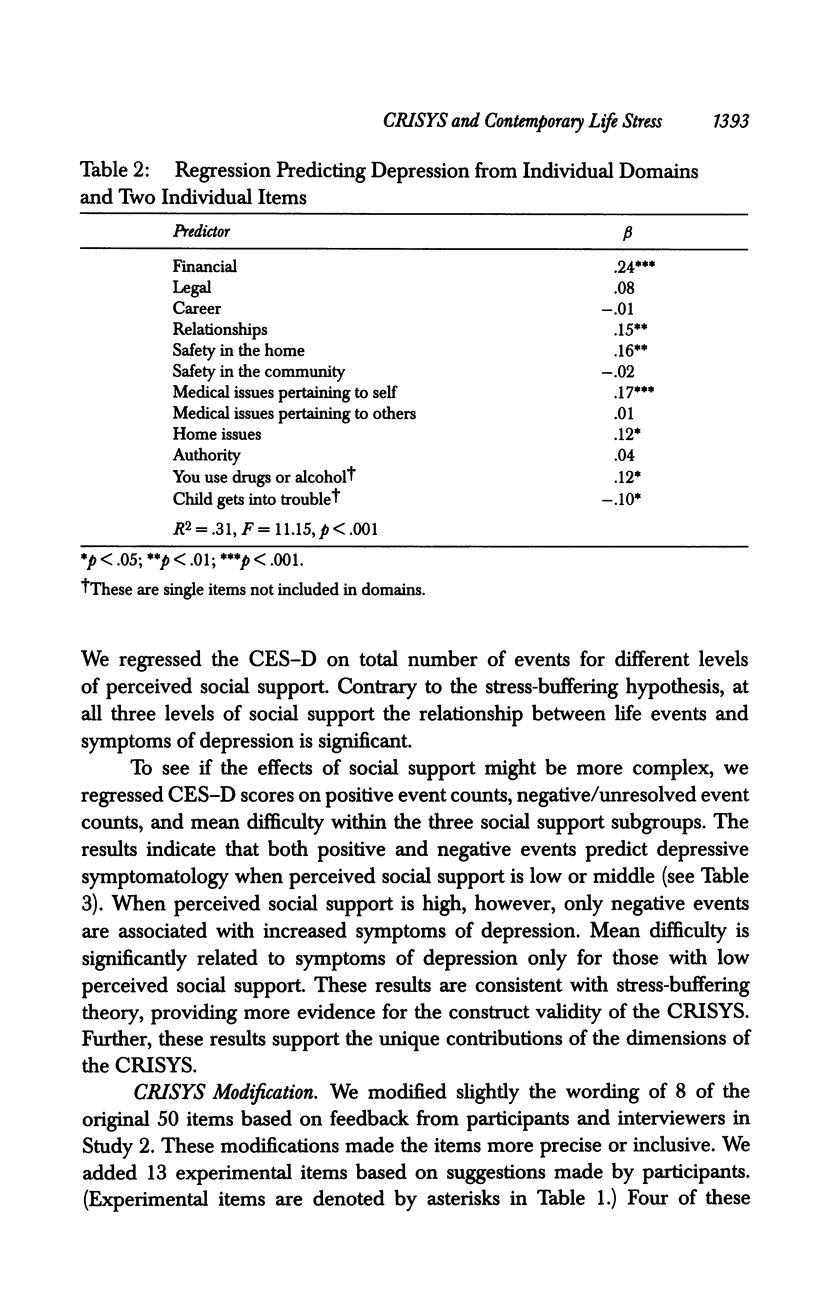
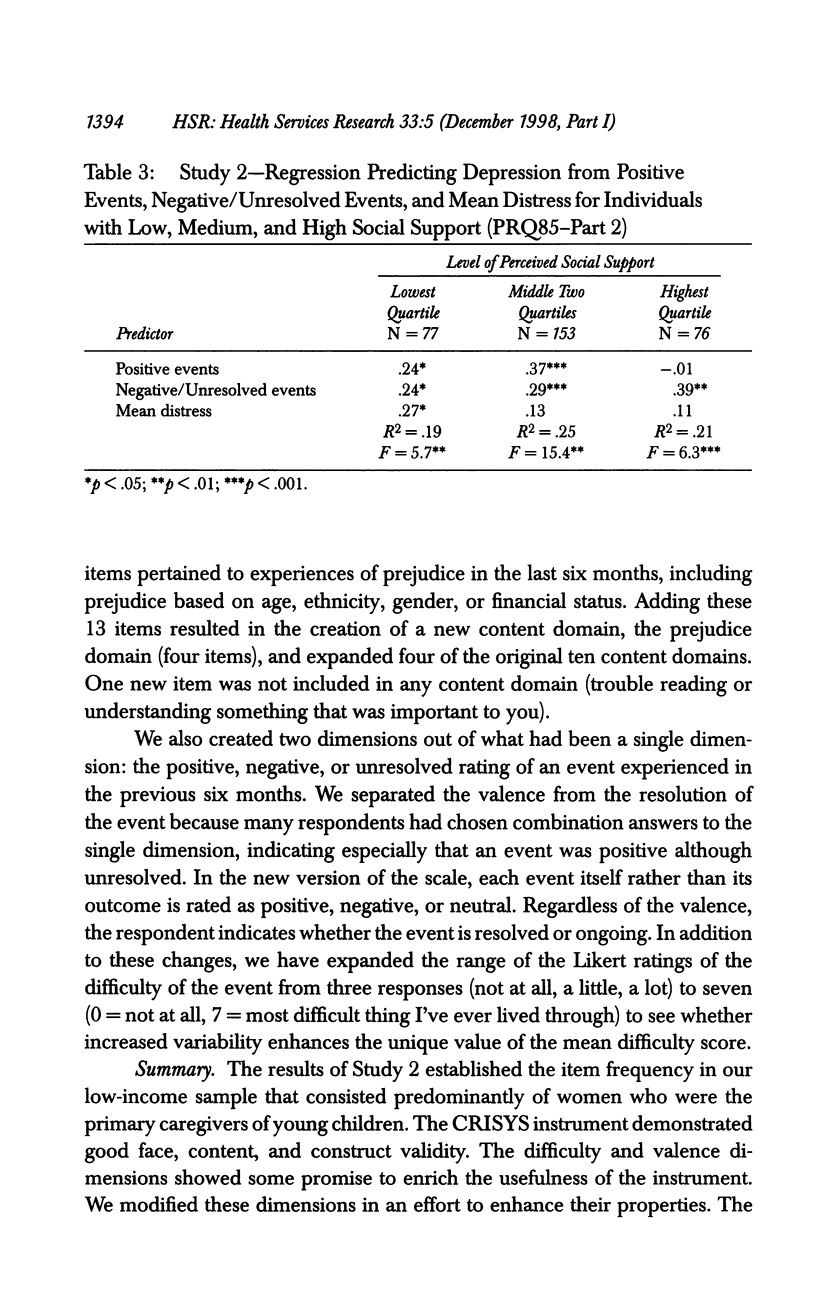
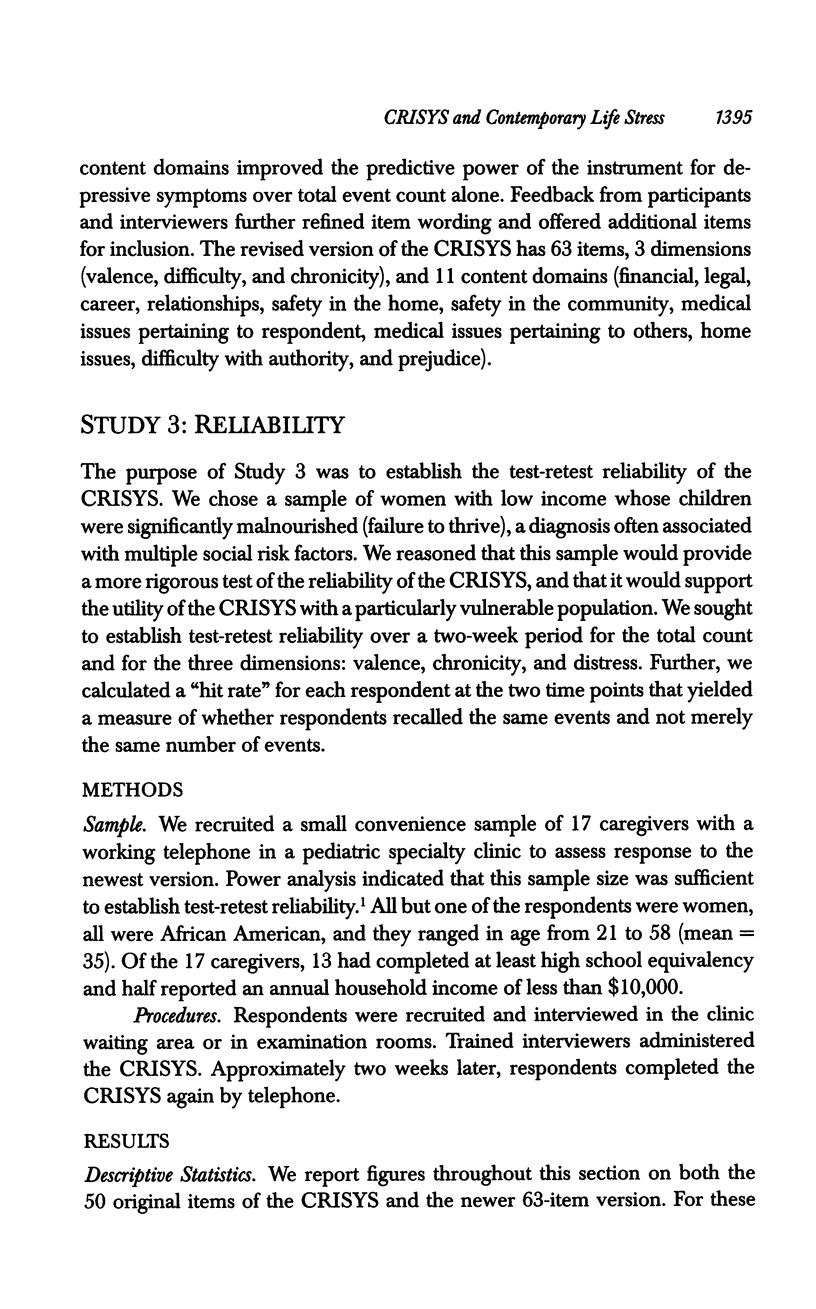
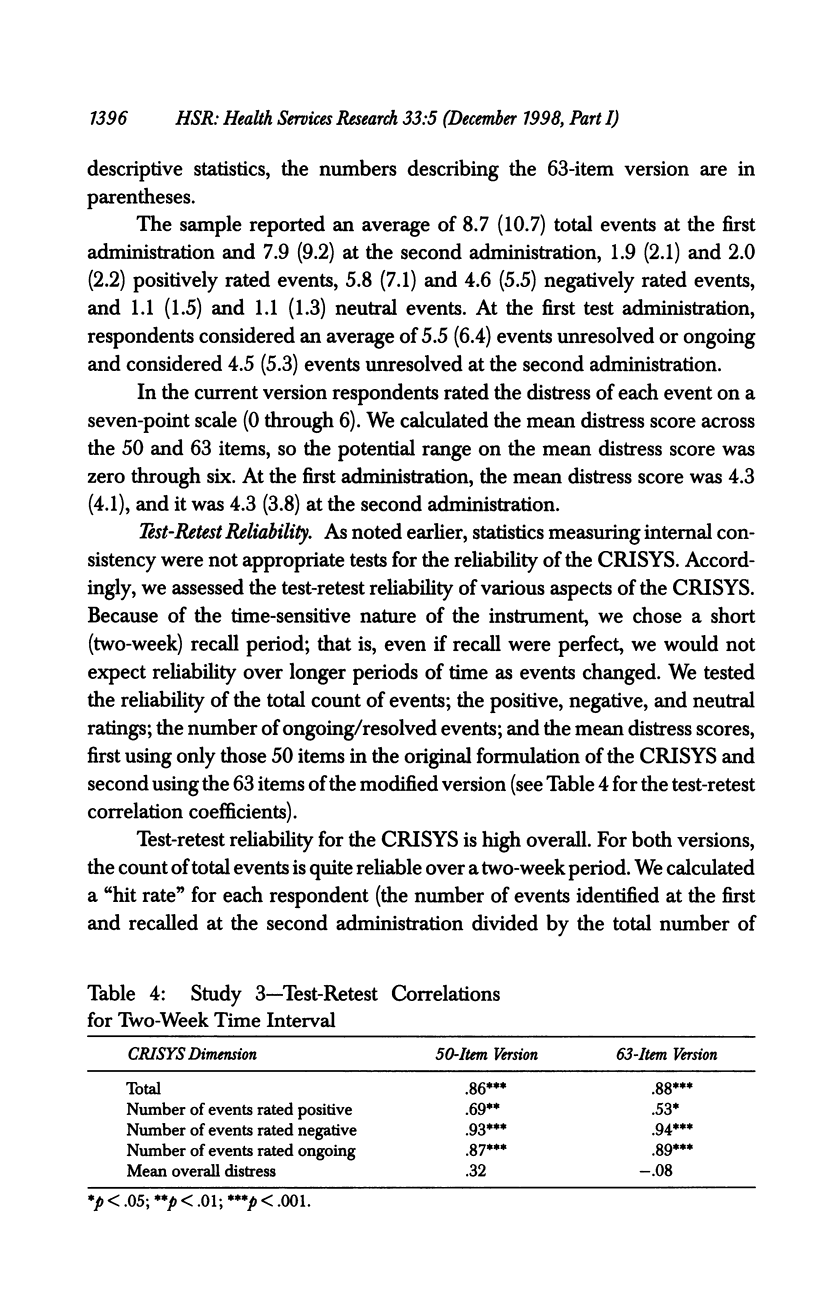






Selected References
These references are in PubMed. This may not be the complete list of references from this article.
- Brandt P. A., Weinert C. The PRQ--a social support measure. Nurs Res. 1981 Sep-Oct;30(5):277–280. [PubMed] [Google Scholar]
- Brown G. W., Birley J. L. Crises and life changes and the onset of schizophrenia. J Health Soc Behav. 1968 Sep;9(3):203–214. [PubMed] [Google Scholar]
- Burns E. I., Doremus P. C., Potter M. B. Value of health, incidence of depression, and level of self-esteem in low-income mothers of pre-school children. Issues Compr Pediatr Nurs. 1990 Apr-Jun;13(2):141–153. doi: 10.3109/01460869009009032. [DOI] [PubMed] [Google Scholar]
- Cohen L. H., McGowan J., Fooskas S., Rose S. Positive life events and social support and the relationship between life stress and psychological disorder. Am J Community Psychol. 1984 Oct;12(5):567–587. doi: 10.1007/BF00897213. [DOI] [PubMed] [Google Scholar]
- Cohen S., Wills T. A. Stress, social support, and the buffering hypothesis. Psychol Bull. 1985 Sep;98(2):310–357. [PubMed] [Google Scholar]
- Dohrenwend B. S., Dohrenwend B. P., Dodson M., Shrout P. E. Symptoms, hassles, social supports, and life events: problem of confounded measures. J Abnorm Psychol. 1984 May;93(2):222–230. doi: 10.1037//0021-843x.93.2.222. [DOI] [PubMed] [Google Scholar]
- Dohrenwend B. S., Krasnoff L., Askenasy A. R., Dohrenwend B. P. Exemplification of a method for scaling life events: the Peri Life Events Scale. J Health Soc Behav. 1978 Jun;19(2):205–229. [PubMed] [Google Scholar]
- DuBois D. L., Felner R. D., Brand S., Adan A. M., Evans E. G. A prospective study of life stress, social support, and adaptation in early adolescence. Child Dev. 1992 Jun;63(3):542–557. doi: 10.1111/j.1467-8624.1992.tb01645.x. [DOI] [PubMed] [Google Scholar]
- Funch D. P., Marshall J. R. Measuring life stress: factors affecting fall-off in the reporting of life events. J Health Soc Behav. 1984 Dec;25(4):453–464. [PubMed] [Google Scholar]
- Gorman D. M. A review of studies comparing checklist and interview methods of data collection in life event research. Behav Med. 1993 Summer;19(2):66–73. doi: 10.1080/08964289.1993.9937567. [DOI] [PubMed] [Google Scholar]
- Hall L. A. Prevalence and correlates of depressive symptoms in mothers of young children. Public Health Nurs. 1990 Jun;7(2):71–79. doi: 10.1111/j.1525-1446.1990.tb00615.x. [DOI] [PubMed] [Google Scholar]
- Holmes T. H., Rahe R. H. The Social Readjustment Rating Scale. J Psychosom Res. 1967 Aug;11(2):213–218. doi: 10.1016/0022-3999(67)90010-4. [DOI] [PubMed] [Google Scholar]
- Jenkins C. D., Hurst M. W., Rose R. M. Life changes. Do people really remember? Arch Gen Psychiatry. 1979 Apr;36(4):379–384. doi: 10.1001/archpsyc.1979.01780040021001. [DOI] [PubMed] [Google Scholar]
- Kanner A. D., Coyne J. C., Schaefer C., Lazarus R. S. Comparison of two modes of stress measurement: daily hassles and uplifts versus major life events. J Behav Med. 1981 Mar;4(1):1–39. doi: 10.1007/BF00844845. [DOI] [PubMed] [Google Scholar]
- Kemper K. J., Babonis T. R. Screening for maternal depression in pediatric clinics. Am J Dis Child. 1992 Jul;146(7):876–878. doi: 10.1001/archpedi.1992.02160190108031. [DOI] [PubMed] [Google Scholar]
- Orr S. T., James S. A., Charney E. A Social Environment Inventory for the pediatric office. J Dev Behav Pediatr. 1989 Dec;10(6):287–291. [PubMed] [Google Scholar]
- Parikh R. M., Eden D. T., Price T. R., Robinson R. G. The sensitivity and specificity of the Center for Epidemiologic Studies Depression Scale in screening for post-stroke depression. Int J Psychiatry Med. 1988;18(2):169–181. doi: 10.2190/bh75-euya-4fm1-j7qa. [DOI] [PubMed] [Google Scholar]
- Paykel E. S. Methodological aspects of life events research. J Psychosom Res. 1983;27(5):341–352. doi: 10.1016/0022-3999(83)90065-x. [DOI] [PubMed] [Google Scholar]
- Paykel E. S., Myers J. K., Dienelt M. N., Klerman G. L., Lindenthal J. J., Pepper M. P. Life events and depression. A controlled study. Arch Gen Psychiatry. 1969 Dec;21(6):753–760. doi: 10.1001/archpsyc.1969.01740240113014. [DOI] [PubMed] [Google Scholar]
- Rabkin J. G., Struening E. L. Live events, stress, and illness. Science. 1976 Dec 3;194(4269):1013–1020. doi: 10.1126/science.790570. [DOI] [PubMed] [Google Scholar]
- Raphael K. G., Cloitre M., Dohrenwend B. P. Problems of recall and misclassification with checklist methods of measuring stressful life events. Health Psychol. 1991;10(1):62–74. doi: 10.1037//0278-6133.10.1.62. [DOI] [PubMed] [Google Scholar]
- Roberts R. E., Vernon S. W. The Center for Epidemiologic Studies Depression Scale: its use in a community sample. Am J Psychiatry. 1983 Jan;140(1):41–46. doi: 10.1176/ajp.140.1.41. [DOI] [PubMed] [Google Scholar]
- Ross C. E., Mirowsky J., 2nd A comparison of life-event-weighting schemes: change, undesirability, and effect-proportional indices. J Health Soc Behav. 1979 Jun;20(2):166–177. [PubMed] [Google Scholar]
- Sarason I. G., Johnson J. H., Siegel J. M. Assessing the impact of life changes: development of the Life Experiences Survey. J Consult Clin Psychol. 1978 Oct;46(5):932–946. doi: 10.1037//0022-006x.46.5.932. [DOI] [PubMed] [Google Scholar]
- Skinner H. A., Lei H. The multidimensional assessment of stressful life events. J Nerv Ment Dis. 1980 Sep;168(9):535–541. doi: 10.1097/00005053-198009000-00003. [DOI] [PubMed] [Google Scholar]
- Turner R. J., Avison W. R. Innovations in the measurement of life stress: crisis theory and the significance of event resolution. J Health Soc Behav. 1992 Mar;33(1):36–50. [PubMed] [Google Scholar]
- Weinert C., Tilden V. P. Measures of social support: assessment of validity. Nurs Res. 1990 Jul-Aug;39(4):212–216. [PubMed] [Google Scholar]
- Zimmerman M. Weighted versus unweighted life event scores: is there a difference? J Human Stress. 1983 Dec;9(4):30–35. doi: 10.1080/0097840X.1983.9935028. [DOI] [PubMed] [Google Scholar]


